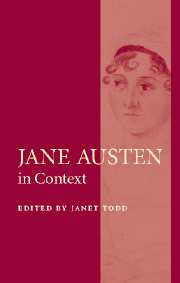40 - Transport
Published online by Cambridge University Press: 19 December 2020
Summary
Any appraisal of transport in Austen's day must begin with the recognition that the prime way of covering the ground for most people was still to go on foot. Men and women, young and old, urban inhabitants and country dwellers – all were accustomed to walking more regularly than we do today. Some eccentrics covered huge amounts of ground, as a sport or simply as a means of winning bets. Perhaps the best-known example of a long-distance pedestrian is John ‘Walking’ Stewart (1749–1822), who hoofed his way around Europe and North America. Recreational walking increased at the end of the eighteenth century, with the growth of organised tourism. However, ordinary folk made what seem by our standards extensive trips on foot in the course of their daily business. All these kinds meet in William and Dorothy Wordsworth. The couple thought nothing of trotting from Grasmere to Keswick (or back) over a hilly pass for a short visit to Coleridge, who made the return trip just as often. Dorothy routinely took long walks with Mary Hutchinson, who later married her brother; and at the age of forty-six, a year after Jane Austen's death, she undertook her first ascent of England's highest mountain, Scafell Pike, together with a friend named Miss Barker and a guide. It is the same with William, who met John Stewart: his work is suffused with what might be called the culture of walking, as well as the mere physical activity. Aptly Robin Jarvis devotes a chapter in his study of Romantic Writing and Pedestrian Travel to ‘William Wordsworth: Pedestrian Poet’.
It hardly needs saying that fine ladies and smart gentlemen were less inclined to exercise their limbs in pursuit of health or recreation – they had horses and carriages for that. Nevertheless, even well-bred young women were permitted to take a turn to approved destinations, for social or communal purposes. This can be seen in the ‘lapse’ of Elizabeth Bennet, when she ploughs through the muddy fields and puddles to succour her ailing sister at Nether field Park.
- Type
- Chapter
- Information
- Jane Austen in Context , pp. 425 - 433Publisher: Cambridge University PressPrint publication year: 2005



